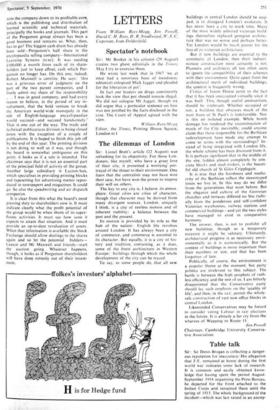The dilemmas of London
Sir: Lionel Brett's article (22 August) was refreshing for its objectivity. For those Lon- doners, like myself, who have a great love of their city, it presented a worrying por- trayal of the threat to their environment. One fears that the centralists may not have won their case, but have won the power to impose their will on others.
The key to any city is, I believe, its atmos- phere. Great cities are cities of character, though that character may be derived from many divergent sources. London, uniquely I think, is a city of restless motion and of inherent stability: a balance between the past and the present.
Its motion is provided by its role as the hub of the nation: English life revolves around London. It has always been a city of commerce, and commerce is essential to its character. But equally, it is a city of his- tory and tradition, containing, as it does, some of the finest architecture in Western Europe: buildings through which the whole development of the city can be traced.
To say, as some people do, that all new buildings in central London should be stop- ped, is to disregard London's evolution. It has never been a city to mark time. Many of the most widely admired victorian build- ings themselves replaced georgian architec- ture that was no worse and perhaps better. Yet London would be much poorer for the loss of its victorian architecture.
But if new buildings are essential to the continuity of London, then their indiscri- minate construction most certainly is not. Planners and architects all too often seem to ignore the compatibility of their schemes with their environment. Quite apart from the architectural merit of individual buildings, the context is frequently wrong.
Critics of Juxon House point to the fact that it has been unoccupied virtually since it was built. This, though useful ammunition, should be irrelevant. Whether occupied or not, a building that obscures much of the west front of St Paul's is indefensible. Nor is this an isolated example. While bomb damage has rendered the reconstruction of much of the City inevitable, could anyone claim that those responsible for the Barbican redevelopment have made any attempt to come to terms with the surroundings? In- stead of being integrated with London life, the whole scheme has been divorced from it. It is perhaps significant that in the middle of the site, hidden almost completely by con- crete blocks and steel girders, is the beauti- ful old church of St Giles Cripplegate.
It is 'true that the harshness and medio- crity of the Barbican reflect the stereotyped times we live in. In this way do we differ from the generations that went before. But the elegance and culture of the Georgian churches and terraces differed no less radic- ally from the ponderous and self-confident Victorian warehouses, railway stations and commercial buildings—and yet the two styles have managed to exist in comparative harmony.
The answer, then, is not to prohibit all new buildings, though as a temporary measure it might be salutary. Ultimately, architectural progress is as necessary envir- onmentally as it is economically. But the context of buildings is more important than their numbers or size, and that has been forgotten of late.
Politically, of course, the environment is a popular theme at the moment, but party politics are irrelevent to this subject. The battle is between the high prophets of ruth- less efficiency and the rest of us. I am bitterly disappointed that the Conservative party should lay such emphasis on the 'quality of life', and then, in the Gt_c, permit the whole- sale construction of vast new office blocks in central London.
Liketninded Conservatives may be forced to consider voting Labour in GLC elections in the future. It is already a far cry from the wharves of Wapping to Route 11.
Jim Powell Chairman. Cambridge University Conserva- tive Association.






























 Previous page
Previous page